Terms
- Bidimensional Acculturation Model (BAM): an acculturation model; reviews one’s relationships with receiving and heritage cultures (Berry, 1997).
- Empowerment Theory (ET): an umbrella term; incorporates theories that focus on social hierarchies and inequalities (Robbins, Chatterjee, & Canda, 2011).
- Phenomenology: a theoretical framework and approach to inquiry; centers around the investigation of lived experiences (Robbins et al., 2011).
- Transitioning: a process; moving from one status to another (Blackburn, 2016; Kelly, 2016).
- Veteran Migrants (VMs): former service members who stay in the country they served, which is different from their country of origin (Chishti, Rose, & Yale-Loehr, 2019).
This presentation contains an overview of three theories and models that can be applied to a specific problem. The presentation will discuss the problem and demonstrate the value that the three theories can offer a study that is focused on it. This slide showcases the key terms, including the three theories and the primary definitions of the problem that is being discussed. The presentation will review the usefulness of BMA, ET, and phenomenology for the transitioning processes that VMs experience as they go from military life to civilian life and adapt to living in a new country.
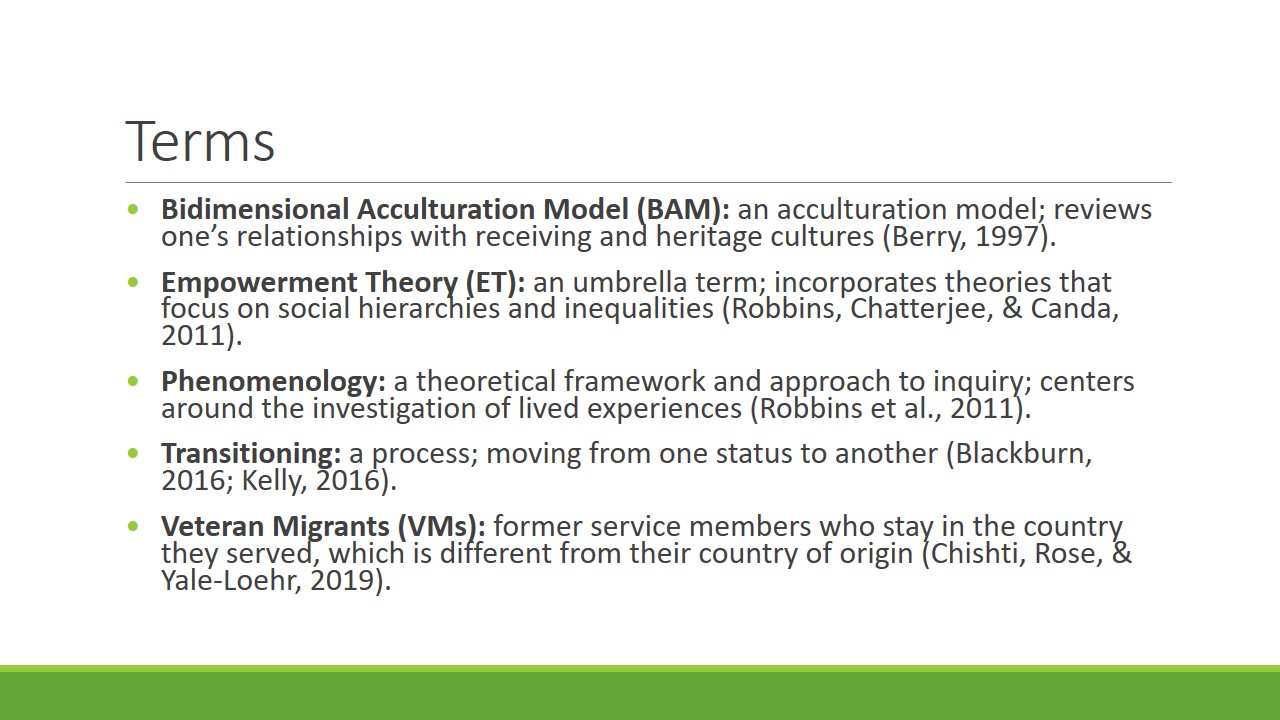
Statement & Significance of the Problem
- The military as a migration mechanism (Chishti et al., 2019):
- orare (roughly 760,000 people in total);
- osocially important (the lack of human resources in the military).
- Dual transitioning:
- osignificant challenges (healthcare, finances, communication);
- odual acculturation.
- Little research, especially Latino VMs.
The population of VMs, especially Latino VMs, is not very large; over the entirety of the US history, about 760,000 people migrated to the country this way. However, VMs satisfy the demand of the US military for human resources, and they are a vulnerable group. As reported by the Organization for Security and Co-operation in Europe [OSCE] (2018) and the US Department of Veterans Affairs [DVA] (2018), transitioning can be rather difficult, especially if no appropriate supports are offered to migrants or veterans. For VMs, the dual transition must be characterized by dual challenges, but an overview of relevant literature demonstrates that the topic is barely covered, especially for Latino VMs.
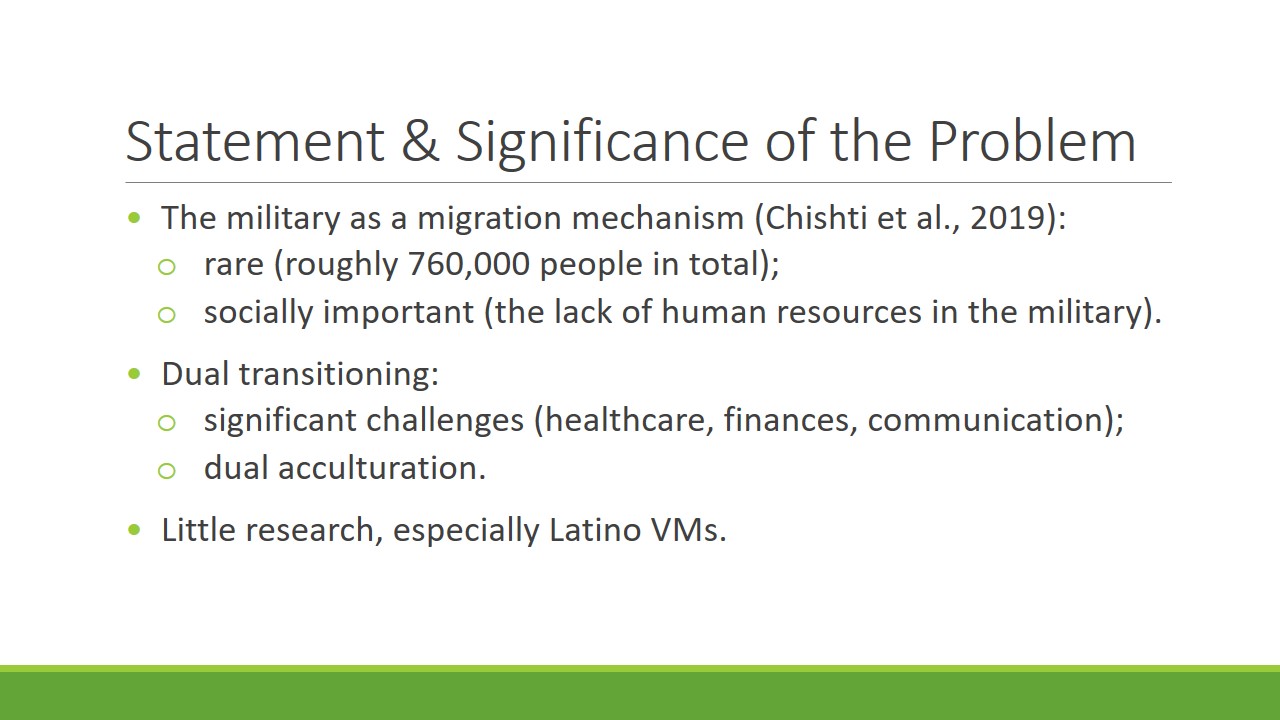
Significance of the Problem & Goals
- To determine the needs of migrants and veterans;
- To understand their interaction in Latino VMs;
- To determine unique Latino VM needs and improve social services aimed at them.
Therefore, such research needs to be provided, which explains the importance of reviewing relevant theories. Such inquiry would be beneficial for determining the needs of migrants and veterans, as well as the combined needs of VMs. This way, the research would produce data on Latino VM experiences and needs, which would be useful for the services that are provided to that population.
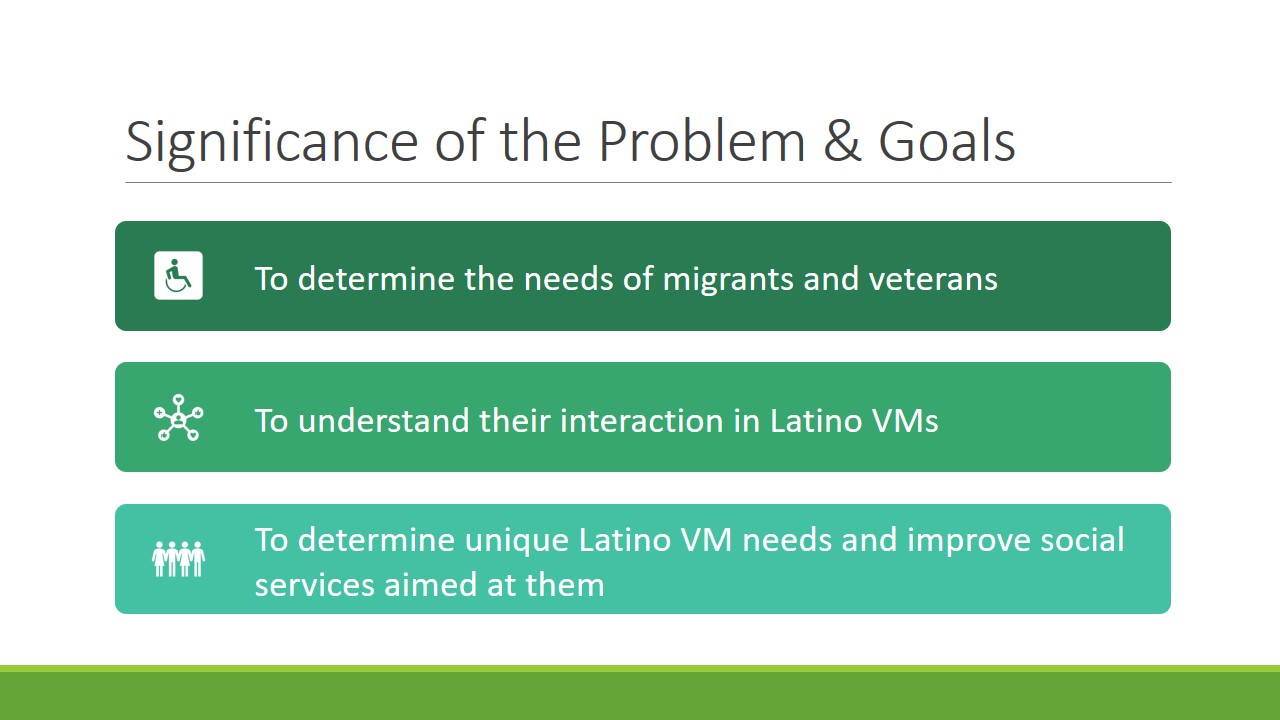
Phenomenology: Assumptions/Concepts
- Positivism-critical: focus on subjectivity and social constructionism (Robbins et al., 2011).
- The value of subjective views and experiences.
- Introducing different perspectives (Nicola, 2017).
Phenomenology is a framework that has been created to critique positivism with its focus on objectivity. Consequently, it is concerned with subjectivity and humans’ ability to develop social constructs that are not objective phenomena. As a research framework, phenomenology is concerned with experiences and perspectives; they are considered important for critiquing social constructs and preventing one view from being a dominant one.
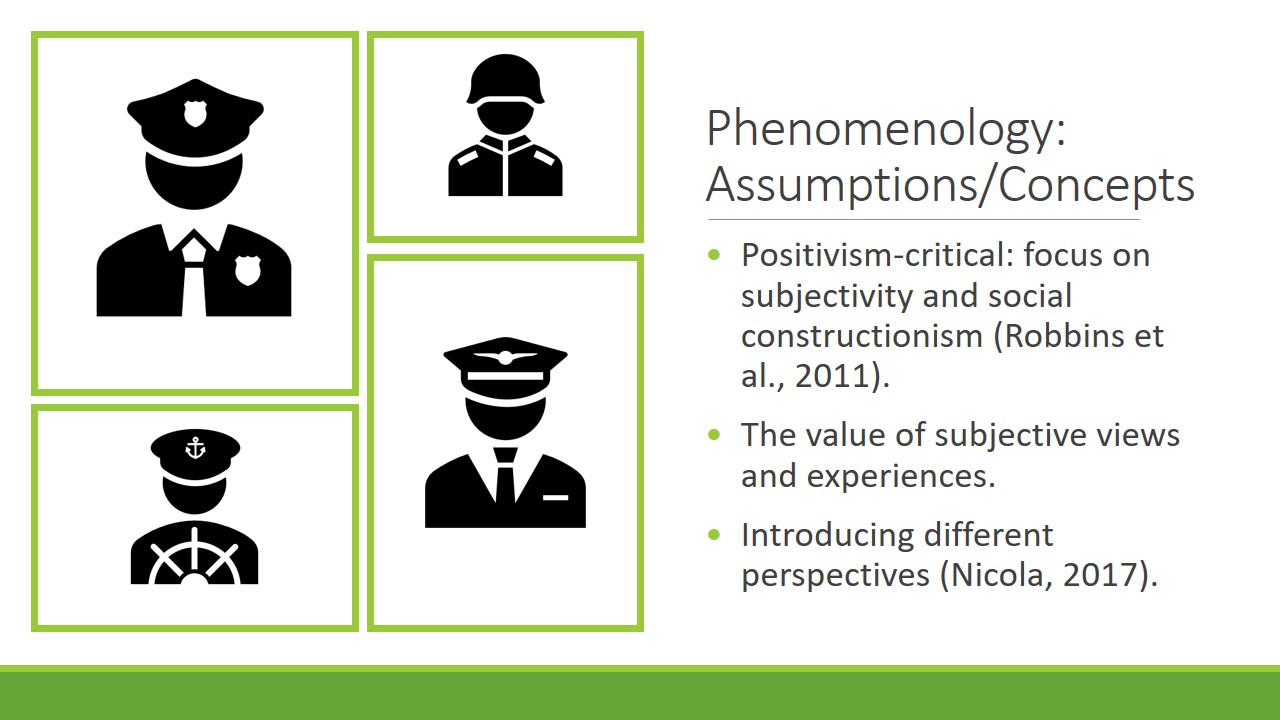
Phenomenology: Application
- Used for methodology development and analysis (interpretation); practice-oriented.
- The experiences of migrants (Ballysingh, 2019; DeRose, 2018; Nicola, 2017).
- The experiences of veterans (Daniels, 2017).
- Benefits: engaging and empowering; can give voice; can provide insights into needs.
- Drawbacks: rather broad.
Over time, phenomenology has been used to guide studies that considered the experiences of migrants and veterans, even though no such works for Latino VMs or simply VMs were encountered. The theory’s primary benefits are that it can engage the studied population and offer them the opportunity to voice their concerns; they can be considered the primary and most important source of information on their needs, which is crucial for social work. However, phenomenology is not especially specific, which calls for its augmentation with more specific models.
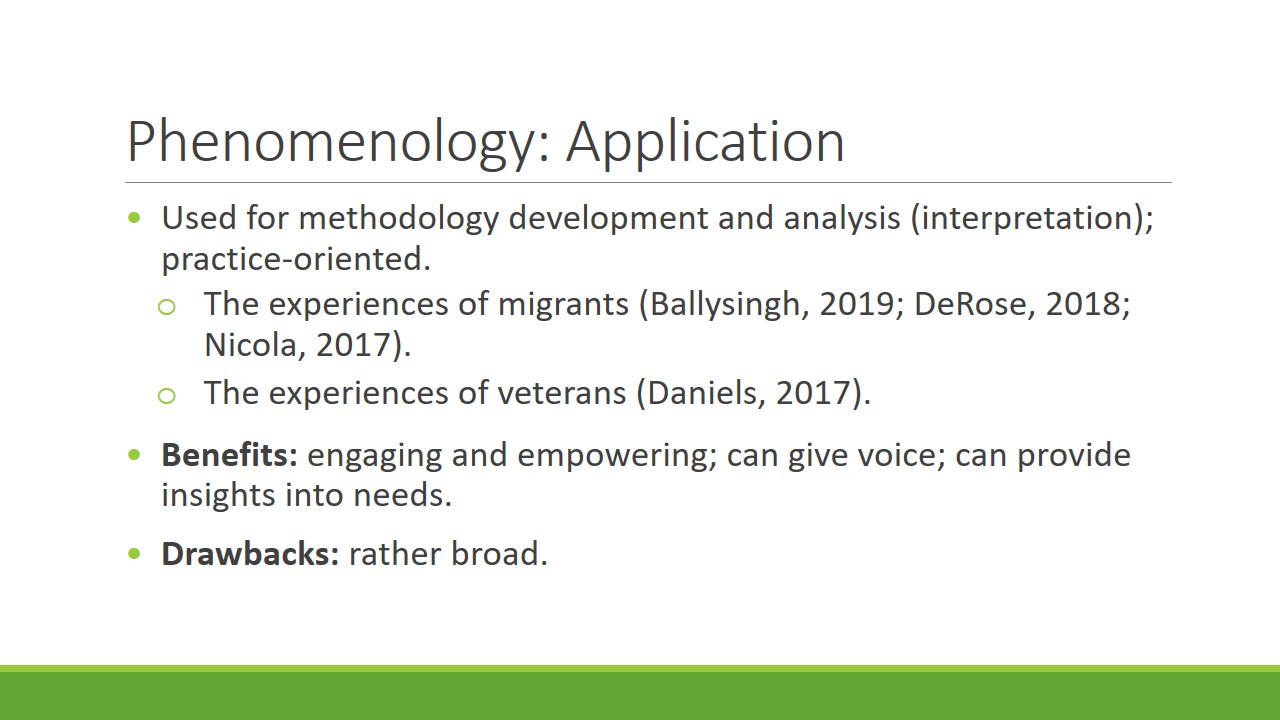
BMA: Assumptions/Concepts
- Heritage Culture (HC) – the culture of the country of origin.
- Receiving Culture (RC) – the culture of the country of migration.
- Four outcomes based on one’s interaction with both (Berry, 1997).
BMA by Berry (1997) suggests that acculturation and its outcomes are defined by an individual’s interaction with the culture of the country of origin (alternatively termed heritage culture) and that of their migration country (receiving culture). With four possible outcomes, BMA does not take into account the change in acculturation outcomes over time, but it is still a rather nuanced approach to the topic (Robbins et al., 2011).
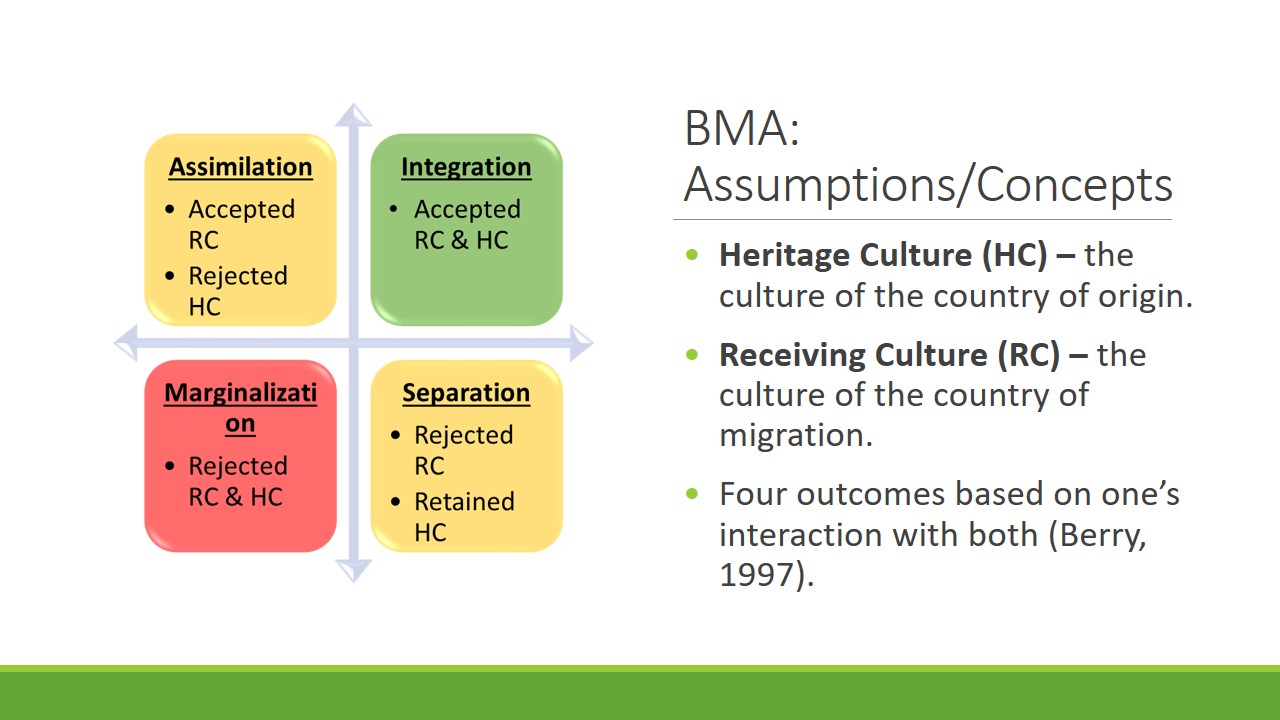
BMA: Application
- Used to guide analysis and methodology development in migrant studies (Meca et al., 2017).
- Can be applied to veterans (military and civilian culture) (Daniels, 2017; Pease, Billera, & Gerard, 2015).
- Benefits: specific; relatively nuanced (Robbins et al., 2011).
- Drawbacks: narrow; does not include time; does not presuppose looking at intersections between two different types of cultural transitioning.
BMA, logically, has been applied to migrants (and even Latino migrants) in research (Meca et al., 2017). While an article that would use it to frame a study on veterans was not found, articles that discuss military culture and transitioning from it do exist (Daniels, 2017; Pease et al., 2015). Therefore, BMA is applicable and usable, and it can produce a nuanced framework for discussing VM acculturation. However, it cannot be used for anything else, and it is not exactly meant for analyzing the dual process of transitioning through more than two cultures, which means that it cannot describe Latino VMs’ experiences in diverse detail.
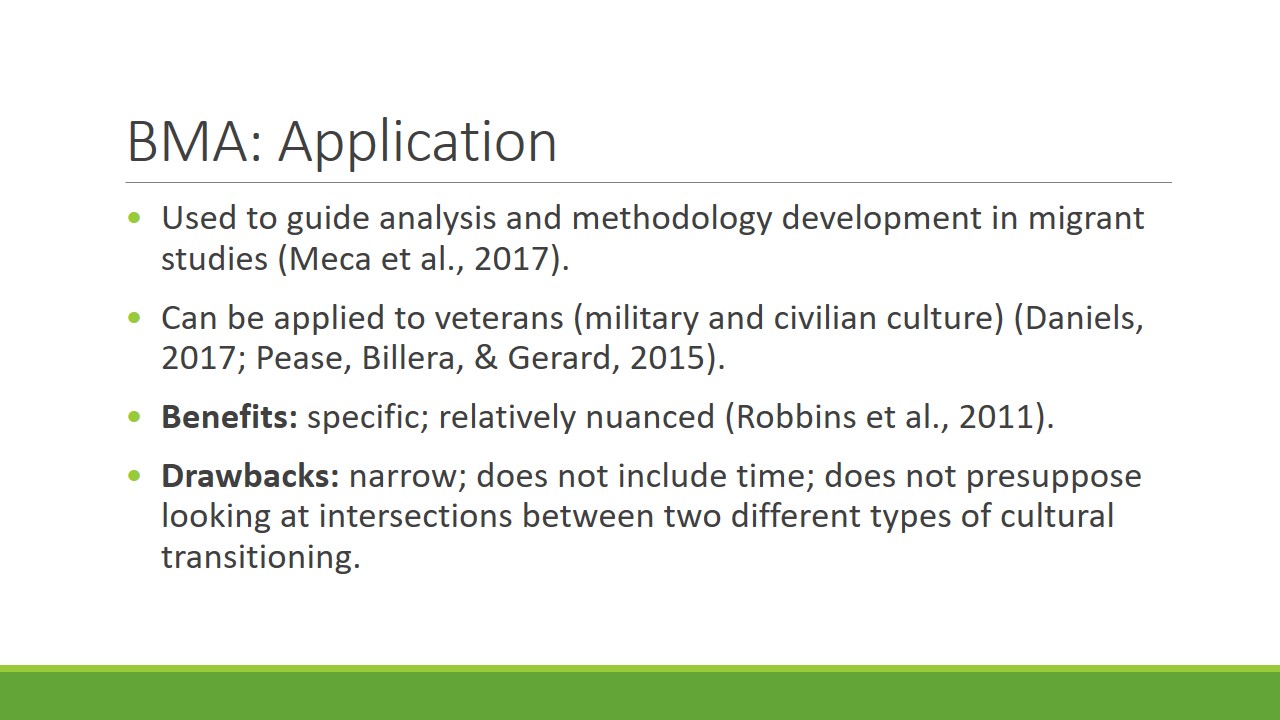
ET: Assumptions/Concepts
- Reviews social interactions in terms of hierarchies, stratification, and oppression (Robbins et al., 2011).
- The possibility of different modes of oppression interacting.
ET is not just one theory; rather, it incorporates many theories that center around the questions of hierarchies and oppression. According to ET, social hierarchies tend to determine one’s access to resources, which results in inequalities and systemic oppression (Robbins et al., 2011). Also, ET posits that oppression can exist in different modes (for instance, based on race, orientation, and so on) and that their intersections form new oppression patterns that deserve to be investigated on their own.
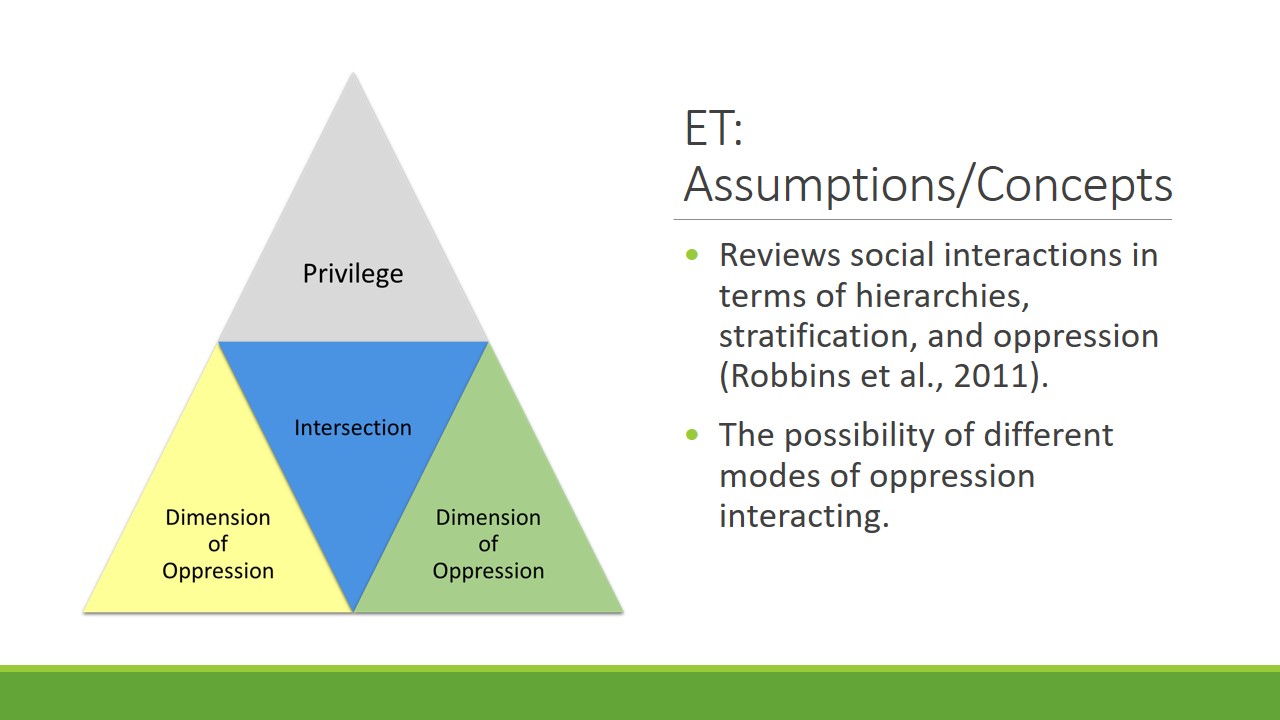
ET: Application
- Used to guide data collection and analysis for migrants (Ballysingh, 2019).
- Can be used for migrants and veterans (different types of inequalities) (Alarcón et al., 2016; DVA, 2018).
- Benefits: practice-oriented; all-encompassing; can offer a framework for intersections of statuses (e.g., VMs).
- Drawbacks: rather broad (more specific versions can be chosen); focuses on disparities.
In recent studies, ET has been used to discuss the empowerment of migrant Latino students (Ballysingh, 2019), but ET is suitable for Latino VMs as well. The fact that migrants are a minority is self-evident (Alarcón et al., 2016); also, disparities can be found between the US veterans and the general population (DVA, 2018). Since the model can describe the intersections of oppression, it is especially relevant for VMs. Also, it is a practice-oriented, broad approach, which can be viewed as a benefit. Alternatively, the broadness can be an issue since it prevents a generalized ET from offering more detailed insights, but it is possible to choose a more specific form of ET. Also, the factors of VMs’ experiences that are not disparity-related are of little interest to ET. In other words, there are limitations to ET’s application, but it is still a valuable framework.
An important observation is that the main assumptions of the three theories are not in contradiction. It can be proposed that phenomenology is aligned with ET because of its interest in the voices that are disempowered, and BMA is attached to ET because acculturation typically occurs in a minority group. As an example, an article by Nicola (2017) involved the concepts of both ET and phenomenology in a study of undocumented Latino immigrants, pointing out the importance of introducing immigrants’ own perspectives on the topic. No other articles, especially ones dedicated to Latino VMs, were found to illustrate the possibility, but this slide offers an example of research topics that are guided by more than one theory.
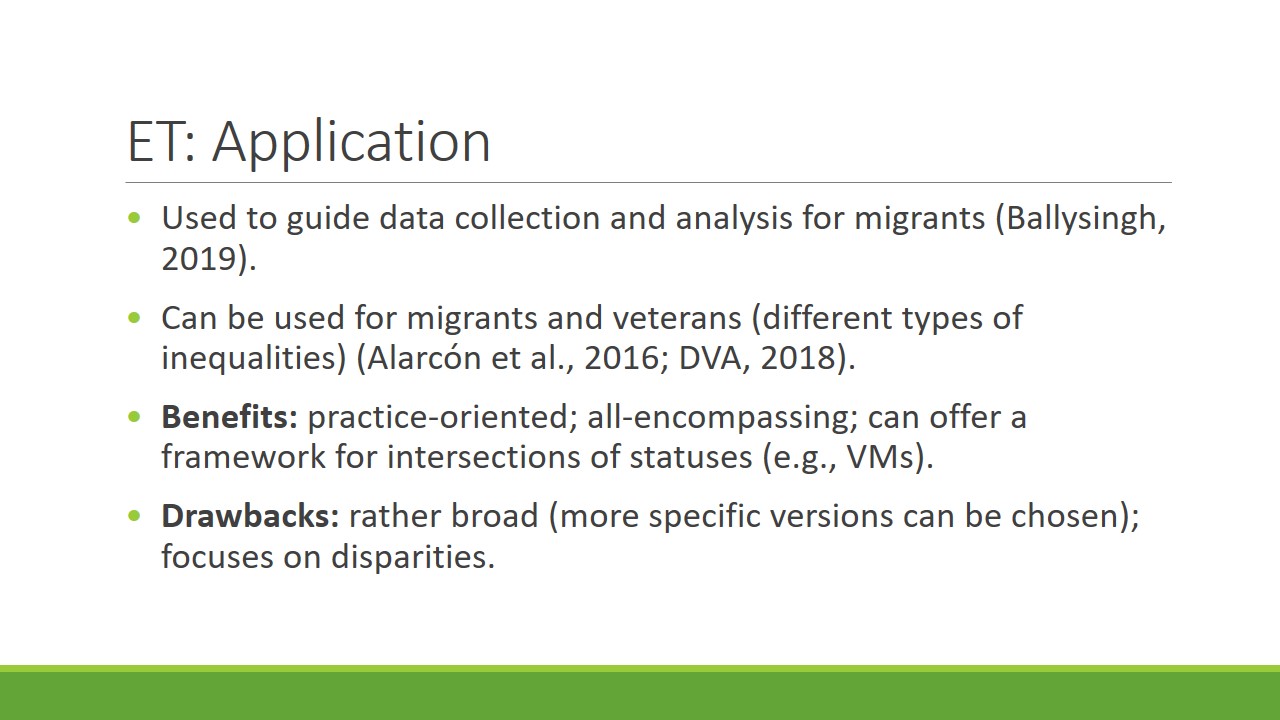

Conclusions
- Theories with strengths and drawbacks;
- Can complement/mitigate issues in each other;
- Have been only rarely applied to veterans/migrants;
- Not applied to Latino VMs;
- Not enough for VMs (even in combination);
- VMs need a specific model.
To summarize, the three presented theories have their own strengths and drawbacks, which enables them to complement each other, especially as long as a broader, less specific framework is used together with a more specific model. In addition, the sources that would directly apply any of the theories to veterans or migrants are not very numerous, and no such sources were found for Latino VMs, which is not surprising given the general scarcity of such literature. Finally, it cannot be said that the presented models introduce a framework that would be sufficient for describing VM and Latino VM experiences in detail. Basically, phenomenology is too broad for details, ET views the topic from one (if rather broad) angle, and BMA is specific but cannot be applied to topics outside of it. As a result, the primary recommendation on the problem-related research is to develop a new integrated model for Latino VMs.
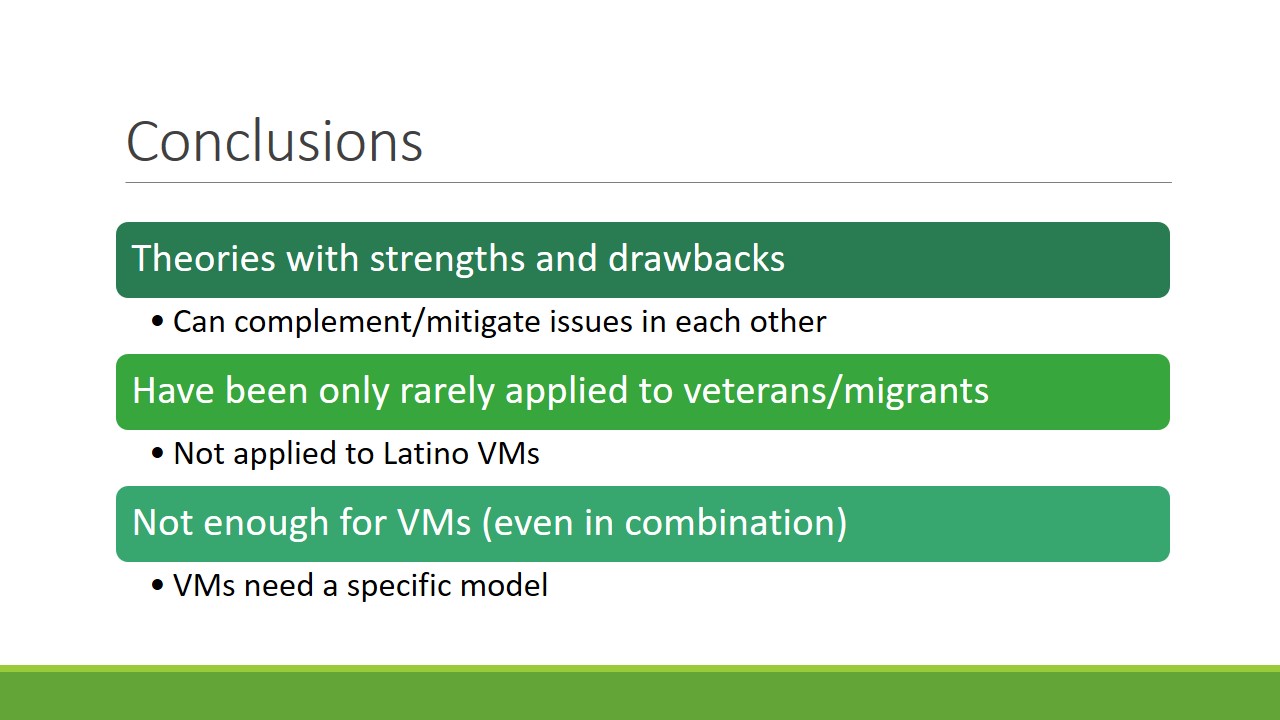
References
Alarcón, R. D., Parekh, A., Wainberg, M. L., Duarte, C. S., Araya, R., & Oquendo, M. A. (2016). Hispanic immigrants in the USA: Social and mental health perspectives. The Lancet Psychiatry, 3(9), 860-870. Web.
Ballysingh, T. (2019). The varied college pathways of Latino young adults: A narrative study of empowerment theory. Professional School Counseling, 23(1). Web.
Berry, J. W. (1997). Immigration, acculturation, and adaptation. Applied Psychology, 46, 5–68. Web.
Blackburn, D. (2016). Transitioning from military to civilian life: Examining the final step in a military career. Canadian Military Journal, 16(4), 53-61.
Chishti, M., Rose, A., & Yale-Loehr, S. (2019). Noncitizens in the US Military. Web.
Daniels, W. C. (2017). A phenomenological study of the process of transitioning out of the military and into civilian life from the acculturation perspective. Web.
DeRose, B. (2018). The Latino immigrants’ experience in obtaining required childhood vaccinations. Journal of Transcultural Nursing, 29(4), 363-368. Web.
Kelly, D. R. (2016). Applying acculturation theory and power elite theory on a social problem: Political underrepresentation of the Hispanic population in Texas. Hispanic Journal of Behavioral Sciences, 38(2), 155-165.
Meca, A., Cobb, C., Xie, D., Schwartz, S., Allen, C., & Hunter, R. (2017). Exploring adaptive acculturation approaches among undocumented Latinos: A test of Berry’s model. The Counseling Psychologist, 45(8), 1115-1140. Web.
Nicola, W. (2017). Living “illegally”: On the phenomenology of an undocumented immigrant. Clinical Social Work Journal, 45(4), 293-300. Web.
Organization for Security and Co-operation in Europe. (2018). Good practices in migrant integration: Trainer’s manual. Web.
Pease, J. L., Billera, M., & Gerard, G. (2015). Military culture and the transition to civilian life: Suicide risk and other considerations. Social Work, 61(1), 83-86.
Robbins, S. P., Chatterjee, P., & Canda, E. R. (2011). Contemporary human behavior theory (3rd ed.). Upper Saddle River, NJ: Pearson Education.
US Department of Veterans Affairs. (2018). The military to civilian transition 2018. Web.